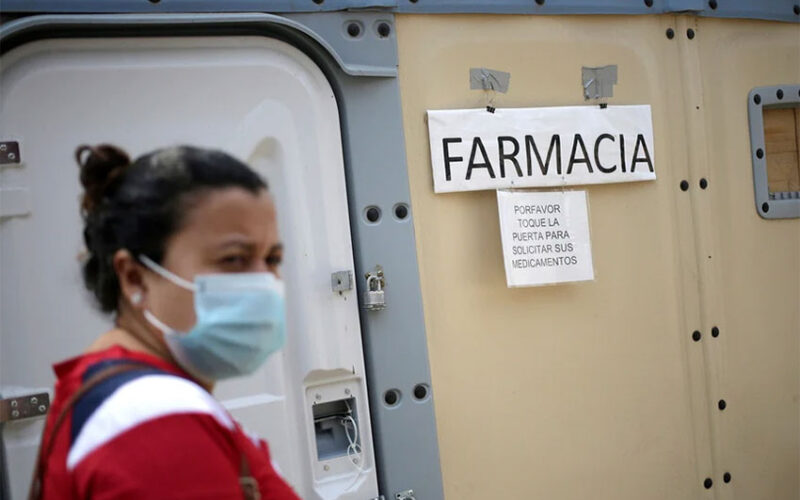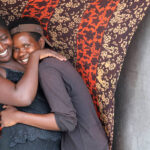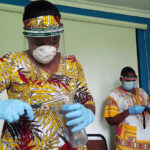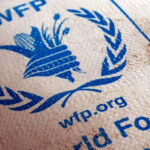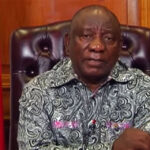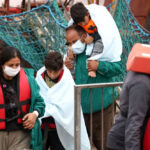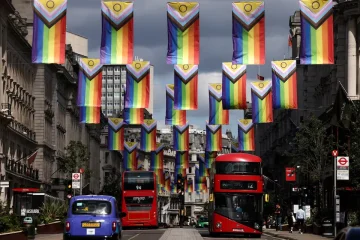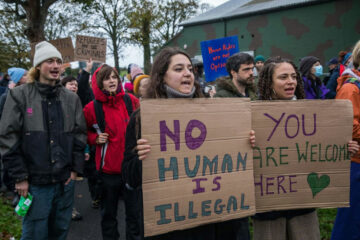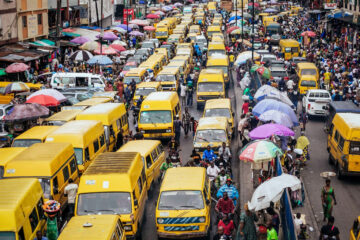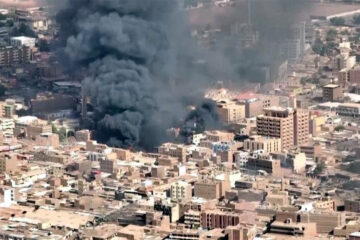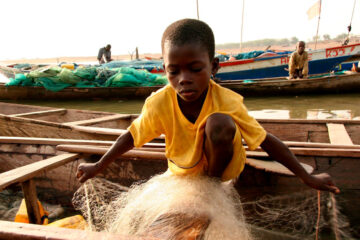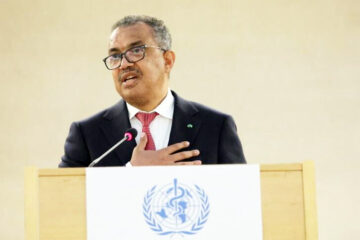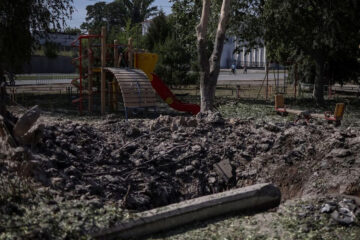ERIC REIDY
On 11 March 2020, the World Health Organization declared the beginning of the COVID-19 pandemic. As the virus first began spreading outside China, there was widespread fear that refugees, asylum seekers, and internally displaced people living in camps and densely populated urban areas would be hit particularly hard.
For reasons that still confound experts, the high death rates predicted in these settings have not come to pass – at least so far. As of mid-February, nearly 50,000 cases of COVID-19 and around 450 deaths have been recorded out of a global population of more than 80 million refugees and displaced people.
“What’s being reported suggests that what’s happening in the Global South in general, and refugee camps in particular, it’s not what was expected,” Heaven Crawley, a professor of international migration at Coventry University in the UK, told The New Humanitarian.
Instead, the impacts of the pandemic on these populations – from border closures, slumping economies, the overlapping of crises, increasing xenophobia, and the use of the virus as an excuse to restrict access to asylum – have been “far more pernicious”, Crawley said. “It’s the poverty and inequality that kills people, not the virus.”
Now, the highly unequal initial rollout of vaccines around the world has advocates and experts concerned that – barring some exceptions, like Jordan, where refugees are already being vaccinated – refugees, asylum seekers, and migrants will largely be left out as countries push to inoculate their citizens first.
“My gut feeling [is] that there’ll be a token amount of refugees and undocumented migrants given access to the vaccine, but it’s going to take time, and they’re going to be left further behind until most nationals have had access,” Paul Spiegel, director of the Center for Humanitarian Health at Johns Hopkins University in the United States, told TNH.
Ultimately, advocates worry that the unequal distribution of vaccines will help cement policies that have restricted the mobility of vulnerable populations and access to protection during the pandemic as part of a “new normal”, even as economic hardship and dwindling humanitarian aid budgets increase the need for many people to migrate.
“[The] combination of increased needs but less capability to migrate, that leads to people being stuck. It could lead to frustrations,” Bram Frouws, head of the Mixed Migration Centre (MMC), said. “I think that’s what we’re going to see increasing, and what we’re already seeing now.”
An unclear, confusing picture
In the first months of the pandemic, conditions in camps and densely populated urban areas in countries with weak public health systems – where the vast majority of the world’s displaced populations live – were expected to be particularly susceptible to devastating COVID-19 outbreaks because of the inability of people to socially distance, lack of access to water, sanitation and hygiene facilities, and limited access to healthcare.
A year later, the virus has made its way to every corner of the world. Inevitably, cases have been recorded in refugee camps in Greece, among Rohingya refugees in Cox’s Bazar, in the makeshift camp housing asylum seekers close to the US southern border in Matamoros, Mexico, in Dadaab refugee camp in Kenya, and in many other locations.
The number of recorded infections and deaths is almost certainly an undercount, and there is a good chance that transmission rates have been much higher than reported, according to Spiegel, although it is difficult to tell because of limited testing and the absence of high-quality seroprevalence surveys that would show how many people in these settings have developed antibodies.
“It appears as if the transmission may be, in many of these situations, relatively high,” Spiegel said. “What seems to be still unclear is why it appears as if the hospitals were not overwhelmed and… at least again reported deaths were not as high as we would have anticipated.”
The surprisingly low recorded death rate is not unique to refugees, asylum seekers, IDPs and migrants, but has been a phenomenon across many parts of Africa, Asia, and some parts of the Middle East that epidemiologists still have not been able to conclusively explain.
The trend may still change. Recorded COVID deaths increased by 40 percent across Africa between January and February, possibly due to the emergence of more contagious variants, and a second wave in the Middle East at the end of last year caused an uptick in infections and deaths in some countries.
Still, even with such spikes the fatality rate in these areas is significantly lower than expected. One possible explanation is that large numbers of deaths are not being recorded. But Spiegel is sceptical. “If the death rate was high, it would be hard to hide,” he said.
Other more probable hypotheses, or partial explanations, include younger overall populations and lower obesity levels leading to lower mortality, past infections with other viruses providing a degree of immune protection from COVID-19, and warm weather and societies where more of life takes place outdoors leading to lower overall transmission rates. But even within similar settings there are contradictions that don’t really make sense, according to Spiegel.
“What is frustrating to me… is we still don’t have a very good idea of what is happening, and that seems to me just inexcusable,” he said. “Without knowing, it makes it much more difficult to respond in the short term and then, ultimately, [to respond] to future similar sorts of epidemics and pandemics.”
Secondary effects
Even though the death rate has been lower than expected, it is still a humanitarian priority to contain the spread of the virus and take efforts to decrease mortality, according to Hardin Lang, vice president for programmes and policy at the NGO Refugees International. “However, the pandemic’s indirect or secondary effects have had the biggest impact on the forcibly displaced across the globe,” Lang told TNH.
It’s impossible to paint one comprehensive picture of how the pandemic has affected displaced and mobile populations, Safa Msehli, a spokesperson for the UN’s migration agency, IOM, told TNH. “Vulnerabilities of migrants and asylum seekers are very specific to the context,” Msehli said, adding they also are highly influenced by legal status.
But there are some broad trends. Around the world, already marginalised refugees and displaced communities have been forced further into poverty, women and girls are facing increased exposure to gender based violence and worsening gender inequality, access to education has been further reduced, and people are under increasing pressure to return to unsafe or unstable situations in countries like Syria and Venezuela, according to the UN’s refugee agency, UNHCR.
Meanwhile, border closures and lockdown measures have led to a dramatic decrease in mobility for these populations. Asylum claims in EU countries dropped by 31 percent in 2020, for example, and migration from the Horn of Africa to the Arabian Peninsula – the busiest maritime migration route prior to the pandemic – reduced by 73 percent.
In other places, such as Tunisia and West Africa, the economic effects of COVID – overlapping with other factors – are already leading to increased departures or the revival of previously dormant migration routes. Out of almost 5,000 asylum seekers and migrants surveyed by the Mixed Migration Centre between April 2020 and the end of January this year, almost 50 percent said COVID was a factor in why they decided to leave their homes.
COVID has also led to a 40 percent spike in the number of people around the world in need of humanitarian aid. But traditional donor countries, facing their own pandemic induced crises, are pouring billions of dollars into domestic relief packages. “[That] is trickling down to fewer availability of resources for foreign aid,” Frouws, from the Mixed Migration Centre, said.
Looking ahead
The shift of focus inward will likely have other consequences as well. “Usually, when economies go into recession people become a bit more conservative or nationalistic, and ‘let’s care for our own population first’,” Frouws added. “It’s not a very conducive environment to progressive approaches towards migration.”
From the beginning, the pandemic has been leveraged by governments to restrict access to protection. There are 144 countries that still have border closures in place, and more than 60 have not made any exceptions for refugees or asylum seekers. Pushbacks of asylum seekers at the EU’s external borders, in the Andaman Sea and at the US-Mexico border have also proliferated in the past year with the virus used as a distraction or excuse.
In the coming year, mobility – both international and domestic – is expected to become increasingly linked to vaccination. Yet only 57 percent of refugee-hosting countries with vaccination plans in place have committed to vaccinating refugees, and as of February only five European countries had made an explicit commitment to include undocumented migrants in their vaccine drives.
“I think we might see the systematic exclusion of these populations from accessing vaccines,” Faisal Garba, a sociology lecturer at the University of Capetown in South Africa and expert on migration, told TNH. “And then, of course, using that as a pretext to limit people’s movement.”
“It’s just another layer of documentation and paperwork, and things that people don’t have access to in order to seek protection,” Crawley, from Coventry University, said. “I just fear that the kind of things that have become normalised over this period will remain.”

